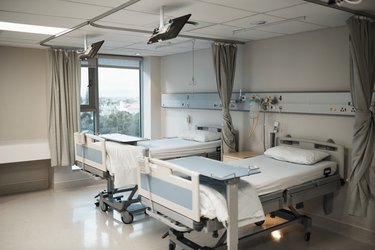
Hospitals have grown over the years to focus on a variety of patient types. They may be divided by floor or wing into wards where different types of patients, nurses and doctors with special expertise and specialized equipment are kept. Beyond medical and practical reasons, wards may be designated to facilitate the mental well-being of patients as well.
Pediatrics
Video of the Day
In an effort to keep children together, they may be assigned to the pediatrics ward. Aside from pediatrics nurses, doctors and technicians, the ward also may have playrooms rather than lounges for patients. Another aspect is an attempt in some hospitals to make the surroundings more cheerful. To this end, cartoon or animal characters may be painted on the walls and toys may be provided in playrooms and individual rooms.
Video of the Day
Maternity
Because the needs of expectant mothers are very different from most other patients, maternity wards are designed to focus on them. Some hospitals provide rooms that are different for expectant mothers, with more home-like atmospheres. Maternity wards also may have specific delivery rooms rather than operating rooms. These wards also provide facilities for the newborn infants, including incubators and other special needs.
Geriatrics
The geriatrics ward focuses on older adults. There has been some debate as to whether older adults should be segregated in such wards; a study reported in The Journals of Gerontology states older people stay in the hospital in general about the same length of time as other patients. The authors of the study conclude that geriatric patients should be mainstreamed into the hospital as a whole.
Psychiatric
The psychiatric ward houses patients who have mental illnesses. As such, it may have controlled access. The ward may be used to treat patients or for observation. Some psychiatric wards allow patients to check themselves in for observation. These wards may include rooms for individual or group counseling.